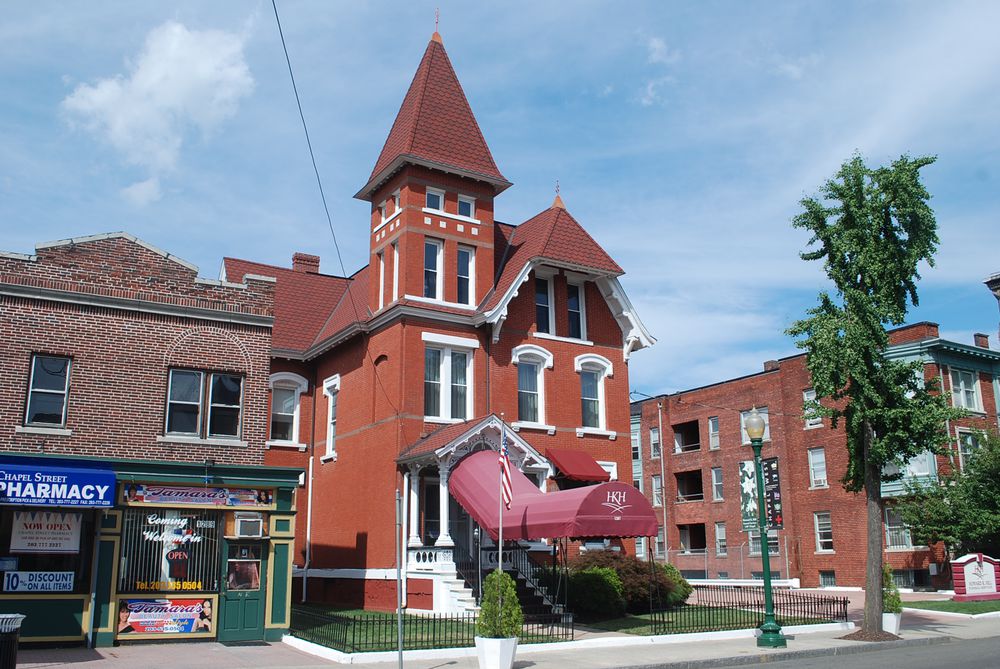
1287 Chapel Street, New Haven, CT
DATE: 1877
ARCHITECTURAL FEATURES: Exhibiting characteristics of both the French-inspired Second Empire architecture which was popular at the time, the building also exhibits characteristics of the burgeoning popular Queen Anne Style in American architecture. The tower element was found in both styles at the residential scale. The roof is really more of a departure from the Second Empire style because it favors a shingle roof over the mansard roofs typical of that time. It utilizes the crisp white trim of the Queen Anne style. The scale of the porch (which has not been enlarged or reduced since the 1886 Sanborn) is small for Queen Anne and the use and variety of materials and ornament is fairly subdued, relating more to the Second Empire.
BACKGROUND: From 1877 until at least 1972, the house was used exclusively as a single family owned (but not necessarily single-family occupied) residence. Four families held the title to the land over this period of time.
CURRENT AND RECENT OWNERS: It is not clear at what date the building started to be used as a commercial space. It has however been used as a funeral home for at least two decades. In 2004, the building contained Bell’s Funeral Home. The current owner, Howard Hill began his business within the existing business and by 2006 owned the building and began a renovation. He did not set out in pursuit of a career in the funeral business. He had been playing the rhythm guitar since elementary school and by the time he graduated from high school he had earned a full scholarship to Berkeley School of Music. But, in 1986, before graduating, Howard fathered a child and left school to take care of the child. Years later he would become one of the busiest Black funeral home owners in the greater New Haven area and he is a strong supporter of the community. “We have to take responsibility as Black people for excellence,” he said. “We tend to be grounded in mediocrity when the customer wants much more and won’t mind paying for it. I offer whatever it takes to satisfy my customers and they know it and they tell their relatives and friends.” He offers free seminars on how to prepare for a death in the family and is partnering with various churches to provide the same. He takes out ads in most community programs and gives $1,000 scholarships to a variety of community organizations and donates money to many others. He calls his community involvement “planting seeds.”
ARCHITECTURAL FEATURES: Exhibiting characteristics of both the French-inspired Second Empire architecture which was popular at the time, the building also exhibits characteristics of the burgeoning popular Queen Anne Style in American architecture. The tower element was found in both styles at the residential scale. The roof is really more of a departure from the Second Empire style because it favors a shingle roof over the mansard roofs typical of that time. It utilizes the crisp white trim of the Queen Anne style. The scale of the porch (which has not been enlarged or reduced since the 1886 Sanborn) is small for Queen Anne and the use and variety of materials and ornament is fairly subdued, relating more to the Second Empire.
BACKGROUND: From 1877 until at least 1972, the house was used exclusively as a single family owned (but not necessarily single-family occupied) residence. Four families held the title to the land over this period of time.
CURRENT AND RECENT OWNERS: It is not clear at what date the building started to be used as a commercial space. It has however been used as a funeral home for at least two decades. In 2004, the building contained Bell’s Funeral Home. The current owner, Howard Hill began his business within the existing business and by 2006 owned the building and began a renovation. He did not set out in pursuit of a career in the funeral business. He had been playing the rhythm guitar since elementary school and by the time he graduated from high school he had earned a full scholarship to Berkeley School of Music. But, in 1986, before graduating, Howard fathered a child and left school to take care of the child. Years later he would become one of the busiest Black funeral home owners in the greater New Haven area and he is a strong supporter of the community. “We have to take responsibility as Black people for excellence,” he said. “We tend to be grounded in mediocrity when the customer wants much more and won’t mind paying for it. I offer whatever it takes to satisfy my customers and they know it and they tell their relatives and friends.” He offers free seminars on how to prepare for a death in the family and is partnering with various churches to provide the same. He takes out ads in most community programs and gives $1,000 scholarships to a variety of community organizations and donates money to many others. He calls his community involvement “planting seeds.”
Researcher
Miriam Peterson
Date Researched
Entry Created
June 4, 2017 at 8:47 AM EST
Last Updated
June 4, 2017 at 8:47 AM EST by null
Historic Name
Style
Current Use
CommercialEra
1638-1860Neighborhood
Chapel WestTours
Westward through Dwight EdgewoodYear Built
1887
Architect
Current Tenant
Roof Types
Structural Conditions
Street Visibilities
Threats
External Conditions
Dimensions
Street Visibilities
Owner
Ownernishp Type
Client
Historic Uses
Residential
Comments
You are not logged in! Please log in to comment.